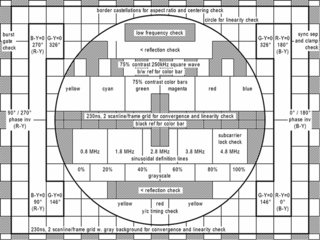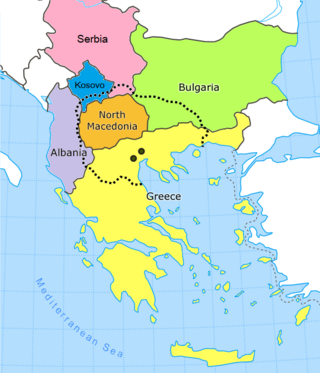
Slow-scan television (SSTV) is a picture transmission method, used mainly by amateur radio operators, to transmit and receive static pictures via radio in monochrome or color.
Amerika is the spelling for "America" in various languages, referring to either the Americas or the United States. It may also refer to:

Amateur television (ATV) is the transmission of broadcast quality video and audio over the wide range of frequencies of radio waves allocated for radio amateur (Ham) use. ATV is used for non-commercial experimentation, pleasure, and public service events. Ham TV stations were on the air in many cities before commercial television stations came on the air. Various transmission standards are used, these include the broadcast transmission standards of NTSC in North America and Japan, and PAL or SECAM elsewhere, utilizing the full refresh rates of those standards. ATV includes the study of building of such transmitters and receivers, and the study of radio propagation of signals travelling between transmitting and receiving stations.
New Amsterdam was the Dutch colonial settlement that later became New York City.

Macedonia most commonly refers to:

An amateur radio repeater is an electronic device that receives a weak or low-level amateur radio signal and retransmits it at a higher level or higher power, so that the signal can cover longer distances without degradation. Many repeaters are located on hilltops or on tall buildings as the higher location increases their coverage area, sometimes referred to as the radio horizon, or "footprint". Amateur radio repeaters are similar in concept to those used by public safety entities, businesses, government, military, and more. Amateur radio repeaters may even use commercially packaged repeater systems that have been adjusted to operate within amateur radio frequency bands, but more often amateur repeaters are assembled from receivers, transmitters, controllers, power supplies, antennas, and other components, from various sources.

Sur Sagar TV, also known as SSTV, is a Canadian Category B Punjabi language specialty channel with select programming in English. It is owned by Ravinder Singh Pannu and features a mix of programming, including movies, news, dramas and music.

The Apollo program used several television cameras in its space missions in the late 1960s and 1970s; some of these Apollo TV cameras were also used on the later Skylab and Apollo–Soyuz Test Project missions. These cameras varied in design, with image quality improving significantly with each successive model. Two companies made these various camera systems: RCA and Westinghouse. Originally, these slow-scan television (SSTV) cameras, running at 10 frames per second (fps), produced only black-and-white pictures and first flew on the Apollo 7 mission in October 1968. A color camera – using a field-sequential color system – flew on the Apollo 10 mission in May 1969, and every mission after that. The color camera ran at the North American standard 30 fps. The cameras all used image pickup tubes that were initially fragile, as one was irreparably damaged during the live broadcast of the Apollo 12 mission's first moonwalk. Starting with the Apollo 15 mission, a more robust, damage-resistant camera was used on the lunar surface. All of these cameras required signal processing back on Earth to make the frame rate and color encoding compatible with analog broadcast television standards.

The Apollo 11 missing tapes were those that were recorded from Apollo 11's slow-scan television (SSTV) telecast in its raw format on telemetry data tape at the time of the first Moon landing in 1969 and subsequently lost.
The Sandinist Television System was a television network in Nicaragua, owned and operated by the government from 1979 to 1990.
Television standards conversion is the process of changing a television transmission or recording from one video system to another. Converting video between different numbers of lines, frame rates, and color models in video pictures is a complex technical problem. However, the international exchange of television programming makes standards conversion necessary so that video may be viewed in another nation with a differing standard. Typically video is fed into video standards converter which produces a copy according to a different video standard. One of the most common conversions is between the NTSC and PAL standards.
France is a country in western Europe.
President most commonly refers to:
SSBC TV (South Sudan Broadcasting Corporation Television) is a public television network in South Sudan which is owned and operated by the South Sudan Broadcasting Corporation. SSBC TV broadcasts in English and Juba Arabic and can also be viewed on Satellite. The network runs a few small local TV stations in Aweil, Wau, Malakal and Rumbek. South Africa, China and Japan provided equipment and training for SSBC TV staff.
Television in Nicaragua has a history of more than fifty years. Canal 8, the first terrestrial television channel in the country, started broadcasting on July 15, 1956. Currently there are more than 15 national terrestrial and cable TV channels.

The 2013–14 Oklahoma Sooners women's basketball team will represent the University of Oklahoma in the 2013–14 NCAA Division I women's basketball season. The Sooners are led by Sherri Coale in her eighteenth season. The team will play its home games at the Lloyd Noble Center in Norman, Oklahoma as a member of the Big 12 Conference. They finished the season with a record 18–15 overall, 9–9 in Big 12 for a tie to finish in fifth place. They lost in the quarterfinals of the 2014 Big 12 women's basketball tournament to Texas. They were invited to the 2014 NCAA Division I women's basketball tournament which they lost in the first round to DePaul.
UPI Newstime was a cable television network founded by United Press International in 1978, and premiered on July 3 of that year. UPI Newstime was the second 24-hour all-news television network in the US for cable TV, following AP Newscable for 13 years and predating CNN by 2 years. UPI Newstime was unique in how it distributed its programming to local cable TV (CATV) headends via satellite, using a form of slow-scan television, or SSTV technology. Using SSTV reduced satellite transmission costs for UPI and was suitable at the time for the programming produced by UPI for the channel, which mainly relied on still slides and wirephotos acquired by UPI's own newsgathering operations.

SSTV or Sun Siyam TV is the private service broadcasting TV channel of the Maldives. It was formed on February 15, 2023. by the founder of SS Media, Ahmed Siyam Ahmed, a Parliament's Meedhoo constituency and the owner of Sun Siyam Resorts who oparates Olhuveli, Iru fushi,Siyam World, etc.








